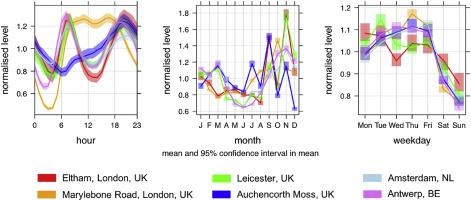当前位置:
X-MOL 学术
›
Atmos. Environ.
›
论文详情
Our official English website, www.x-mol.net, welcomes your feedback! (Note: you will need to create a separate account there.)
The spatio-temporal evolution of black carbon in the North-West European ‘air pollution hotspot’
Atmospheric Environment ( IF 5 ) Pub Date : 2020-12-01 , DOI: 10.1016/j.atmosenv.2020.117874 K.P. Wyche , R.L. Cordell , L. Smith M , K.L. Smallbone , P. Lyons , S.M.L. Hama , P.S. Monks , J. Staelens , J. Hofman , C. Stroobants , E. Roekens , G.P.A. Kos , E.P. Weijers , P. Panteliadis , M.B.A. Dijkema
Atmospheric Environment ( IF 5 ) Pub Date : 2020-12-01 , DOI: 10.1016/j.atmosenv.2020.117874 K.P. Wyche , R.L. Cordell , L. Smith M , K.L. Smallbone , P. Lyons , S.M.L. Hama , P.S. Monks , J. Staelens , J. Hofman , C. Stroobants , E. Roekens , G.P.A. Kos , E.P. Weijers , P. Panteliadis , M.B.A. Dijkema

|
Abstract Particulate black carbon has a range of negative impacts on health, the environment and climate, however despite this there are relatively few long-term studies on its ambient distribution as a tropospheric air pollutant. In order to address this lack of data, to help to provide greater insight into the spatio-temporal distribution of particulate black carbon and to assess potential influencing factors, a new, permanent suburban monitoring network was established with sites in four northwest European cities: London (UK), Leicester (UK), Amsterdam (the Netherlands) and Antwerp (Belgium). We report here an analysis of the first measurements made by the network over a twenty-seven-month period (January 01, 2013–April 01, 2015), alongside data from pre-existing comparator urban roadside (AURN Marylebone Road, London, UK) and rural background (AURN Auchencorth Moss, Scotland) sites. The temporal evolution of black carbon was investigated at each site, as were associations with other commonly monitored pollutants (e.g. O3, NOx, PM2.5, PM10) and wind fields. Results showed clear anthropogenic signatures across the diurnal, weekly and annual timeframes, and positive correlations were obtained between black carbon measurements and other common traffic-related pollutants, highlighting the importance of vehicle emissions as a major contributor to ambient black carbon concentration in northwest Europe. Average black carbon concentrations varied from 6.6 μg m−3 at the urban roadside, to 0.2 μg m−3 in the rural background, with suburban and urban background sites having average concentrations in the range of 1.0–2.4 μg m−3. Wind field analysis further highlighted the importance of road traffic as a source of black carbon and demonstrated the importance of local emission sources at the various receptor locations. Statistical analysis of data between sites generally indicated a weak correlation (rs = −0.03 to 0.68, COD = 0.32–0.91), further highlighting the importance of local emissions in determining ambient black carbon concentration. It was also found that black carbon comprised a significant portion of total ambient particulate matter (PM), particularly at sites with the larger traffic volumes and during rush-hour (e.g. ~45% of PM2.5 at Marylebone Road), however, its contribution to total PM was found to decrease on days of high pollution, indicating the importance of other PM components when air quality is particularly poor.
中文翻译:

西北欧“空气污染热点”中黑碳的时空演变
摘要 颗粒状黑碳对健康、环境和气候有一系列负面影响,尽管如此,关于其作为对流层空气污染物的环境分布的长期研究相对较少。为了解决数据缺乏的问题,帮助更深入地了解微粒黑碳的时空分布并评估潜在的影响因素,在欧洲西北部的四个城市建立了一个新的永久性郊区监测网络:伦敦(英国)、莱斯特(英国)、阿姆斯特丹(荷兰)和安特卫普(比利时)。我们在此报告了对网络在 27 个月期间(2013 年 1 月 1 日至 2015 年 4 月 1 日)进行的首次测量的分析,以及来自预先存在的比较城市路边(AURN Marylebone 路,伦敦,英国)和农村背景(AURN Auchencorth Moss,苏格兰)站点。在每个地点都研究了黑碳的时间演变,以及与其他常用监测污染物(例如 O3、NOx、PM2.5、PM10)和风场的关联。结果显示,在昼夜、每周和每年的时间范围内都有明显的人为特征,并且在黑碳测量值与其他常见交通相关污染物之间获得了正相关,突出了车辆排放作为西北欧环境黑碳浓度的主要贡献者的重要性。平均黑碳浓度从城市路边的 6.6 μg m-3 到农村背景的 0.2 μg m-3 不等,郊区和城市背景站点的平均浓度范围为 1.0-2.4 μg m-3。风场分析进一步强调了道路交通作为黑碳来源的重要性,并证明了各个受体位置的本地排放源的重要性。站点之间数据的统计分析通常表明相关性较弱(rs = -0.03 至 0.68,COD = 0.32–0.91),进一步突出了当地排放在确定环境黑碳浓度方面的重要性。还发现黑碳占总环境颗粒物 (PM) 的很大一部分,特别是在交通量较大的地点和高峰时段(例如,马里波恩路 PM2.5 的约 45%),然而,发现高污染天数对 PM 总量的贡献降低,表明当空气质量特别差时其他 PM 成分的重要性。
更新日期:2020-12-01
中文翻译:

西北欧“空气污染热点”中黑碳的时空演变
摘要 颗粒状黑碳对健康、环境和气候有一系列负面影响,尽管如此,关于其作为对流层空气污染物的环境分布的长期研究相对较少。为了解决数据缺乏的问题,帮助更深入地了解微粒黑碳的时空分布并评估潜在的影响因素,在欧洲西北部的四个城市建立了一个新的永久性郊区监测网络:伦敦(英国)、莱斯特(英国)、阿姆斯特丹(荷兰)和安特卫普(比利时)。我们在此报告了对网络在 27 个月期间(2013 年 1 月 1 日至 2015 年 4 月 1 日)进行的首次测量的分析,以及来自预先存在的比较城市路边(AURN Marylebone 路,伦敦,英国)和农村背景(AURN Auchencorth Moss,苏格兰)站点。在每个地点都研究了黑碳的时间演变,以及与其他常用监测污染物(例如 O3、NOx、PM2.5、PM10)和风场的关联。结果显示,在昼夜、每周和每年的时间范围内都有明显的人为特征,并且在黑碳测量值与其他常见交通相关污染物之间获得了正相关,突出了车辆排放作为西北欧环境黑碳浓度的主要贡献者的重要性。平均黑碳浓度从城市路边的 6.6 μg m-3 到农村背景的 0.2 μg m-3 不等,郊区和城市背景站点的平均浓度范围为 1.0-2.4 μg m-3。风场分析进一步强调了道路交通作为黑碳来源的重要性,并证明了各个受体位置的本地排放源的重要性。站点之间数据的统计分析通常表明相关性较弱(rs = -0.03 至 0.68,COD = 0.32–0.91),进一步突出了当地排放在确定环境黑碳浓度方面的重要性。还发现黑碳占总环境颗粒物 (PM) 的很大一部分,特别是在交通量较大的地点和高峰时段(例如,马里波恩路 PM2.5 的约 45%),然而,发现高污染天数对 PM 总量的贡献降低,表明当空气质量特别差时其他 PM 成分的重要性。



























 京公网安备 11010802027423号
京公网安备 11010802027423号